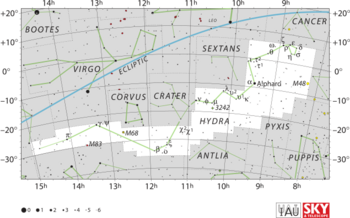Astronomy:Rho Hydrae
| Observation data Equinox J2000.0]] (ICRS) | |
|---|---|
| Constellation | Hydra |
| Right ascension | 08h 48m 25.97057s[1] |
| Declination | +05° 50′ 16.1283″[1] |
| Apparent magnitude (V) | 4.34[2] |
| Characteristics | |
| Spectral type | A0 Vn[3] |
| U−B color index | −0.04[2] |
| B−V color index | −0.04[2] |
| Astrometry | |
| Radial velocity (Rv) | +32.8[4] km/s |
| Proper motion (μ) | RA: −17.33[1] mas/yr Dec.: −29.41[1] mas/yr |
| Parallax (π) | 9.21 ± 0.21[1] mas |
| Distance | 354 ± 8 ly (109 ± 2 pc) |
| Absolute magnitude (MV) | −0.83[5] |
| Details[3] | |
| Mass | 3.24±0.05 M☉ |
| Radius | 2.0[6] R☉ |
| Luminosity | 242 L☉ |
| Temperature | 9,795 K |
| Rotational velocity (v sin i) | 128 km/s |
| Age | 350[7] Myr |
| Other designations | |
| Database references | |
| SIMBAD | data |
Rho Hydrae, equally written ρ Hydrae, is a binary star[9] in the equatorial constellation of Hydra. It is visible to the naked eye with an apparent visual magnitude of 4.34.[2] The distance to this system, based upon an annual parallax shift of 9.21 mas,[1] is about 354 light years. At that distance, the visual magnitude is diminished by an interstellar extinction of 0.06 magnitudes, due to intervening dust.[7]
The primary component is an A-type main sequence star with a stellar classification of A0 Vn.[3] It has around double[6] the radius of the Sun and 3.2 times the Sun's mass. Rho Hydrae is around 350 million years old[7] and has a high rate of spin, with a projected rotational velocity of 128 km/s. It radiates 242 times the solar luminosity from its outer atmosphere at an effective temperature of 9,795 K.[3] The companion is a magnitude 11.9 star at an angular separation of 12.1 arc seconds along a position angle of 146°, as of 2000.[10]
Name and etymology
This system appears among bright stars in a compact pentagon, resembling a quadrilateral due to the suggestive proximity (close arc distance) to Epsilon Hydrae (ε Hya). This shape in the Greco-Roman tradition, which draws on trading and navigation histories shared with nearby older-recorded astrologies is an asterism that represents the head of the water snake.[11]
This light source, along with comparable strength (apparent magnitude) Epsilon, δ Hya (Lisan al Sudja), ζ Hya, η Hya, and σ Hya (Minchir), were Ulug Beg's Min al Azʽal, "Belonging to the Uninhabited Spot".[12] According to the catalogue of stars in the Technical Memorandum 33-507 - A Reduced Star Catalog Containing 537 Named Stars, Min al Azʽal or Minazal were the title for five stars: δ Hya as Minazal I, η Hya as Minazal II, ε Hya as Minazal III, ρ Hya as Minazal IV and ζ Hya as Minazal V (exclude σ Hya).[13]
In Chinese, 柳宿 (Liǔ Sù), meaning Willow, refers to an asterism consisting of ρ Hydrae, δ Hydra, σ Hydrae, η Hydrae, ε Hydrae, ζ Hydrae, ω Hydrae and θ Hydrae[14] Consequently, ρ Hydrae itself is known as 柳宿四 (Liǔ Sù sì, English: the Fourth Star of Willow).[15]
The people of Groote Eylandt called Unwala, "The Crab", for the star cluster including this star, δ Hya (Lisan al Sudja), ε Hya, η Hya, ζ Hya and σ Hya (Minchir).[16]
References
- ↑ 1.0 1.1 1.2 1.3 1.4 1.5 van Leeuwen, F. (2007), "Validation of the new Hipparcos reduction", Astronomy and Astrophysics 474 (2): 653–664, doi:10.1051/0004-6361:20078357, Bibcode: 2007A&A...474..653V.
- ↑ 2.0 2.1 2.2 2.3 Mermilliod, J.-C. (1986), "Compilation of Eggen's UBV data, transformed to UBV (unpublished)", Catalogue of Eggen's UBV Data (SIMBAD), Bibcode: 1986EgUBV........0M.
- ↑ 3.0 3.1 3.2 3.3 Zorec, J.; Royer, F. (January 2012), "Rotational velocities of A-type stars. IV. Evolution of rotational velocities", Astronomy & Astrophysics 537: A120, doi:10.1051/0004-6361/201117691, Bibcode: 2012A&A...537A.120Z.
- ↑ Wilson, Ralph Elmer (1953), "General Catalogue of Stellar Radial Velocities", Carnegie Institute Washington D.C. Publication (Washington: Carnegie Institution of Washington), Bibcode: 1953GCRV..C......0W.
- ↑ Anderson, E.; Francis, Ch. (2012), "XHIP: An extended hipparcos compilation", Astronomy Letters 38 (5): 331, doi:10.1134/S1063773712050015, Bibcode: 2012AstL...38..331A.
- ↑ 6.0 6.1 Pasinetti Fracassini, L. E. et al. (February 2001), "Catalogue of Apparent Diameters and Absolute Radii of Stars (CADARS)", Astronomy and Astrophysics 367: 521–524, doi:10.1051/0004-6361:20000451, Bibcode: 2001A&A...367..521P.
- ↑ 7.0 7.1 7.2 Gontcharov, G. A. (November 2012), "Spatial distribution and kinematics of OB stars", Astronomy Letters 38 (11): 694–706, doi:10.1134/S1063773712110035, Bibcode: 2012AstL...38..694G.
- ↑ "rho Hya". SIMBAD. Centre de données astronomiques de Strasbourg. http://simbad.u-strasbg.fr/simbad/sim-basic?Ident=rho+Hya.
- ↑ Eggleton, P. P.; Tokovinin, A. A. (September 2008), "A catalogue of multiplicity among bright stellar systems", Monthly Notices of the Royal Astronomical Society 389 (2): 869–879, doi:10.1111/j.1365-2966.2008.13596.x, Bibcode: 2008MNRAS.389..869E.
- ↑ Mason, B. D. et al. (2014), "The Washington Visual Double Star Catalog", The Astronomical Journal 122 (6): 3466–3471, doi:10.1086/323920, Bibcode: 2001AJ....122.3466M.
- ↑ Burnham, Robert (2013), Burnham's Celestial Handbook, An Observer's Guide to the Universe Beyond the Solar System, 2, Courier Corporation, p. 1014, ISBN 978-0486317939, https://books.google.com/books?id=aLbDAgAAQBAJ&pg=PA1014.
- ↑ Allen, R. H. (1963), Star Names: Their Lore and Meaning (Reprint ed.), New York, NY: Dover Publications Inc, p. 249, ISBN 0-486-21079-0, https://archive.org/details/starnamestheirlo00alle/page/249, retrieved 2010-12-12
- ↑ Rhoads, Jack W. (November 15, 1971), Technical Memorandum 33-507-A Reduced Star Catalog Containing 537 Named Stars, Jet Propulsion Laboratory, California Institute of Technology, https://ntrs.nasa.gov/archive/nasa/casi.ntrs.nasa.gov/19720005197_1972005197.pdf
- ↑ (in Chinese) 中國星座神話, written by 陳久金. Published by 台灣書房出版有限公司, 2005, ISBN:978-986-7332-25-7.
- ↑ (in Chinese) AEEA (Activities of Exhibition and Education in Astronomy) 天文教育資訊網 2006 年 5 月 28 日
- ↑ Selin, Helaine, ed. (1997), Encyclopaedia of the history of science, technology, and medicine in non-western cultures, Dordrecht: Kluwer Academic Publishers, p. 105, ISBN 9780792340669, https://books.google.com/books?id=raKRY3KQspsC
 |


